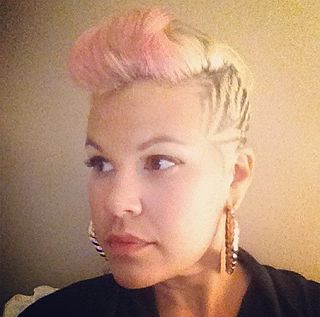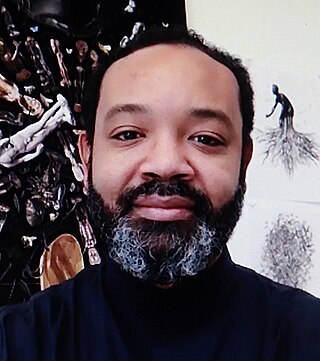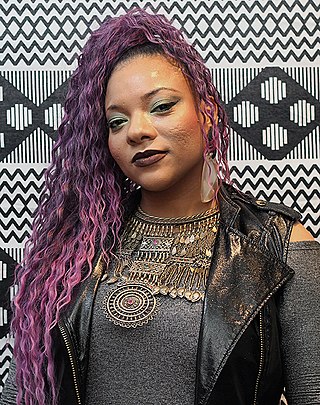
The Studio Museum in Harlem is an American art museum devoted to the work of artists of African descent. The museum's galleries are currently closed in preparation for a building project that will replace the current building, located at 144 West 125th Street between Adam Clayton Powell Jr. Boulevard and Lenox Avenue in Harlem, Manhattan, New York City, with a new one on the same site. Founded in 1968, the museum collects, preserves and interprets art created by African Americans, members of the African diaspora, and artists from the African continent. Its scope includes exhibitions, artists-in-residence programs, educational and public programming, and a permanent collection.
Rodney McMillian is an artist based in Los Angeles. McMillian is a Professor of Sculpture at the UCLA School of Arts and Architecture at the University of California, Los Angeles.
Alison Saar is a Los Angeles, California based sculptor, mixed-media, and installation artist. Her artwork focuses on the African diaspora and black female identity and is influenced by African, Caribbean, and Latin American folk art and spirituality. Saar is well known for "transforming found objects to reflect themes of cultural and social identity, history, and religion."

Terry Roger Adkins was an American artist. He was Professor of Fine Arts in the School of Design at the University of Pennsylvania.
Sanford Biggers is a Harlem-based interdisciplinary artist who works in film/video, installation, sculpture, music, and performance. An L.A. native, he has lived and worked in New York City since 1999.

Heather T. Hart is an American visual artist who works in a variety of media including interactive and participatory Installation art, drawing, collage, and painting. She is a co-founder of the Black Lunch Table Project, which includes a Wikipedia initiative focused on addressing diversity representation in the arts on Wikipedia.
Alvin D. Loving Jr., better known as Al Loving, was an African-American abstract expressionist painter. His work is known for hard-edge abstraction, fabric constructions, and large paper collages, all exploring complicated color relationships.
Charles Gaines is an American artist whose work interrogates the discourse of aesthetics, politics, and philosophy. Taking the form of drawings, photographic series and video installations, the work consistently involves the use of systems, predominantly in the form of the grid, often in combination with photography. His work is rooted in Conceptual Art – in dialogue with artists such as Sol LeWitt, Lawrence Weiner and Mel Bochner – and Gaines is committed to its tenets of engaging cognition and language. As one of the only African-American conceptual artists working in the 1970s, a time when political expressionism was a prevailing concern among African-American artists, Gaines was an outlier in his pursuit of abstraction and non-didactic approach to race and politics. There is a strong musical thread running through much of Gaines' work, evident in his repeated use of musical scores as well in his engagement with the idea of indeterminacy, as similar to John Cage and Sol LeWitt.

Jennie C. Jones is an African-American artist living and working in Brooklyn, New York. Her work has been described, by Ken Johnson, as evoking minimalism, and paying tribute to the cross-pollination of different genres of music, especially jazz. As an artist, she connects most of her work between art and sound. Such connections are made with multiple mediums, from paintings to sculptures and paper to audio collages. In 2012, Jones was the recipient of the Joyce Alexander Wien Prize, one of the biggest awards given to an individual artist in the United States. The prize honors one African-American artist who has proven their commitment to innovation and creativity, with an award of 50,000 dollars. In December 2015 a 10-year survey of Jones's work, titled Compilation, opened at the Contemporary Arts Museum in Houston, Texas.

William Villalongo is an American artist working in painting, printmaking, sculpture, and installation art. Based in Brooklyn, New York, Villalongo is an associate professor at the Cooper Union School of Art in New York.

Abigail DeVille is an artist who creates large sculptures and installations, often incorporating found materials from the neighborhoods around the exhibition venues. DeVille's sculptures and installations often focus on themes of the history of racist violence, gentrification, and lost regional history. Her work often involves a performance element that brings the artwork out of its exhibition space and into the streets; DeVille has organized these public events, which she calls "processionals," in several U.S. cities, including Washington, D.C., Baltimore, and New York. Deville likes to use her own family as inspiration for her art work. She decided to use her grandmother as inspiration because of her vibrant personality, to help her articulate ideas from the neighborhoods of the Bronx. Deville is pleased that her art works are unique, as many people see trash as useless to them, while DeVille instead sees an opportunity.

Kambui Olujimi is a New York-based visual artist working across disciplines using installation, photography, performance, tapestry, works on paper, video, large sculptures and painting. His artwork reflects on public discourse, mythology, historical narrative, social practices, exchange, mediated cultures, resilience and autonomy.
Danielle Dean is a British-American visual artist. She works in drawing, installation, performance and video. She has exhibited in London and in the United States; her work was included in an exhibition at the Hammer Museum focusing on new or under-recognized artists working in Los Angeles.

Nicole Awai is an artist and educator based in Brooklyn, New York and Austin, Texas. Her work captures both Caribbean and American landscapes and experiences and engages in cultural critique. She works in many media including painting, photography, drawing, installations, ceramics, and sculpture as well as found objects.
Sadie Barnette, is an American artist who works primarily with drawing, photography, and large-scale installation. Her work explores Black life, personal histories, and the political through material explorations. She lives in Oakland, California.
Torkwase Dyson is an interdisciplinary artist based in Beacon, New York, United States. Dyson describes the themes of her work as "architecture, infrastructure, environmental justice, and abstract drawing." Her work is informed by her own theory of Black Compositional Thought. This working term considers how spatial networks—paths, throughways, water, architecture, and geographies—are composed by Black bodies as a means of exploring potential networks for Black liberation. She is represented by Pace Gallery and Richard Gray Gallery.
Monument Lab is a public art project based in Philadelphia, Pennsylvania. Created by curators Paul Farber and Ken Lum and Director of Research Laurie Allen, the project is notable for producing a number of works of public art around the city of Philadelphia, often in collaboration with other organizations. In 2020, Mellon Foundation awarded Monument lab a three-year, $4 million grant to aid the Lab's mission.
Kanisha Raja (1970-2018) was born in Calcutta India, and later lived and worked in New York City.
Lauren Halsey is a contemporary American artist. Halsey uses architecture and installation art to demonstrate the realities of urban neighborhoods like South Central, Los Angeles.
Kamau Amu Patton is a multidisciplinary American artist and educator. He makes works independently and as part of the performance collective founded by Terry Adkins, Lone Wolf Recital Corps. Patton is also an Assistant Professor in the Visual & Critical Studies department at the School of the Art Institute of Chicago and on the Bard MFA faculty.







